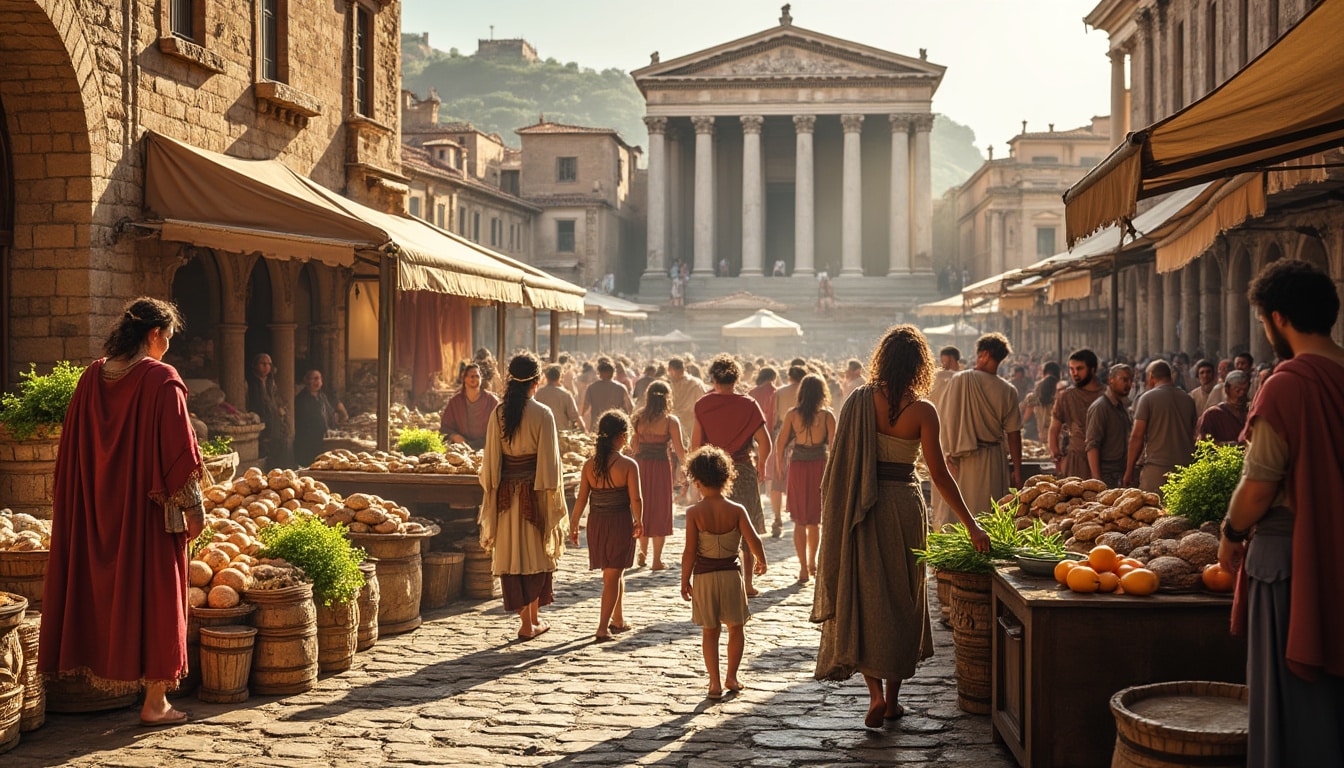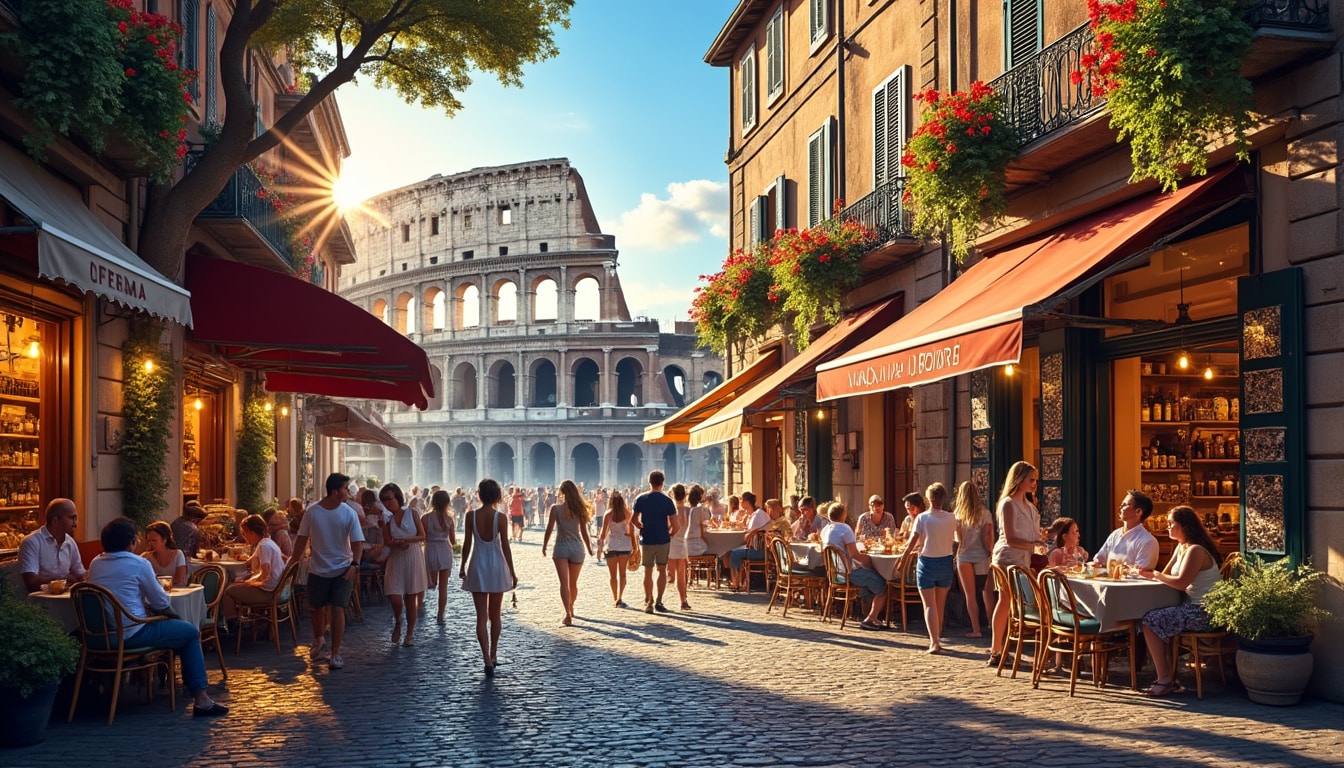Life in ancient Rome was a tapestry of daily routines, social dynamics, and bustling city life. The average Roman’s day was a blend of work, leisure, and social obligations, set against a backdrop of grandeur and complexity that defined the empire. Waking before sunrise, navigating through Rome’s intricate streets, engaging in public entertainment, and partaking in communal bathing — these were the rhythms of a Roman’s life. Whether you were a senator attending a banquet or a plebeian heading to work, the vibrancy of Rome’s daily life was inescapable. From the aroma of fresh bread at the Trastevere Market to savoring coffee at the historic Caffè Sant’Eustachio, the stories of everyday Romans reveal a city alive with tradition, culture, and community.
Mornings in Ancient Rome: Starting the Day
In ancient Rome, the day began early, often before the first light of dawn. Romans awoke to a city already alive with activity. The clamor of schoolmasters, the chatter of bakers, and the rhythmic clang of the coppersmiths’ hammers filled the air, creating a symphony of sounds that was uniquely Roman. This vibrant morning chorus was familiar to every Roman citizen, irrespective of their social class.
The hustle and bustle of Roman mornings can be further understood through the lens of urban life in a city that was not yet illuminated by electric lights. People took full advantage of the daylight hours to conduct their business and chores. With breakfast being a modest affair comprising bread and possibly some wine, the primary nourishment that fueled a Roman’s day was drawn from the vibrancy and urgency surrounding them.
- 🍞 Simple breakfast: Bread, olives, and perhaps some cheese
- ⏰ Workday began at dawn, marking a day packed with activities
- 🏛 Navigating through crowded streets to reach workplaces
Transportation played a significant role in early Roman hours. The chaotic city layout, a result of rapid expansion and recurrent fires, meant that commuting was an adventure in itself. Outsiders had to park their carts outside the city gates due to a decree by Caesar that confined street cart traffic to only construction-related vehicles within the city. Hence, Romans were adept at weaving through a complex mesh of cobbled streets and alleyways, using foot traffic as the primary mode of transportation.
| Time of Day | Activity | Description |
|---|---|---|
| Early Morning 🌅 | Breakfast | Light food to start the day |
| Morning Commute 🚶 | Walking to work | Navigating the bustling streets |
| Mid-Morning ⏳ | Work | Engaging in various professions |
For visitors today, soaking up a slice of morning life in modern Rome often starts with a stop at a place like the Trastevere Market. Here, you can witness a similar hustle and bustle as Romans shop for fresh produce and artisanal goods, reflecting the enduring spirit of the city’s vibrant and lively atmosphere.

Work and Leisure: Balancing Responsibilities and Relaxation in Rome
The Roman workday typically commenced at dawn and concluded around midday. This schedule allowed for afternoons dedicated entirely to leisure and social activities — a crucial component of Roman life, especially given the simple breakfasts that Romans consumed. After a productive morning, citizens would seek entertainment or relaxation, showcasing a juxtaposition between hard work and hedonistic enjoyment.
One hallmark of Roman leisure was the abundance of recreational options. Theaters, bathhouses, and sporting events attracted people from all walks of life. Venues like the Colosseum Cafe, near the iconic Colosseum, echoed with cheers and awe as visitors gathered for gladiatorial games and races. This blending of recreation and community engagement made leisure time a cherished aspect of Roman culture.
- 🎭 Theater: A popular venue for plays and artistic expression
- 🛁 Baths: Social hubs for discussion, exercise, and relaxation
- 🏟 Colosseum: Spectacular events including gladiatorial matches and races
Bathhouses, or thermae, were particularly significant. By the third century BC, they had become a cornerstone of Roman social life. The concept of bathing extended beyond hygiene; it included exercise, socializing, and even business dealings. The thermae had numerous amenities such as enclosed gardens, promenades, and areas for various sports, providing a diverse array of activities under one roof.
| Leisure Venue | Activities Offered | Importance |
|---|---|---|
| Bathhouses 🛁 | Bathing, exercise, social gatherings | Central to daily leisure and community interaction |
| Theaters 🎭 | Plays and performances | Cultural and artistic development |
| Colosseum 🏟 | Gladiator games and races | Entertainment and community bonding |
Today’s visitors can experience the remnants of this lifestyle by visiting Campania’s archaeological sites or enjoying guided Roma Food Tours, where one can dive into the culinary richness that accompanied these leisure practices.
Supper and Evening Rituals: Gathering with Style
The Romans placed a high value on their evening meal, known as cena, which was the main event of their gastronomic day. Supper included elaborate dishes and reflected one’s wealth and social standing. The affluent Romans indulged in multi-course meals with dishes like dormice rolled in honey and poppy seeds, alongside more common fare like salads, meats, and cheeses.
- 🥗 Starters: Salads and appetizers
- 🍖 Main Courses: Variety of meats and seafood
- 🍰 Desserts: Fruits and honey-sweetened confections
Dining practices were just as important as the food itself. Romans reclined on couches around square tables, eating with their hands, which required frequent washing. It was customary to end the meal with drinks of various diluted wines. The setting of these meals was as vital as the food served — from opulent dining rooms in urban homes to rustic courtyards in country villas.
| Course | Common Dishes | Description |
|---|---|---|
| First Course 🍴 | Appetizers, salads | Light to stimulate appetite |
| Main Course 🍖 | Meats, seafood, breads | Rich and diverse selections |
| Dessert 🍰 | Fruits, cheese, sweets | Satisfying and sweet finish |
Visiting vibrant spots such as Gelateria La Romana or tasting wines at Caffè Sant’Eustachio provides tourists today with a peek into the rich flavors and communal dining spirit characterizing old Roman evenings.
Housing and Architecture: The Living Spaces of Romans
The architecture and housing styles of ancient Rome varied significantly depending on one’s social status. Most Romans lived in simple apartments known as insulae, which were cramped and often lacked basic amenities. Conversely, the wealthier classes resided in opulent houses called domus, complete with elaborate atriums and richly decorated interiors.
Urban living conditions were diverse and often distinguished by substantial differences in space allocation and amenities. While insulae provided basic living quarters for the masses, the domus was an expression of wealth with its private baths, lush gardens, and multifaceted floor plans.
- 🏠 Insulae: Basic and small, catering to commoners
- 🏛 Domus: Luxurious homes for the rich
- 🏰 Villas: Country estates for relaxation and retreats
Public architecture played an equally pivotal role in Rome. Notable structures like the Forum and aqueducts underscored Roman engineering prowess while serving critical social functions like politics, trade, and community gatherings. These landmarks continue to invite admiration today for their enduring beauty and engineering brilliance.
| Housing Type | Residents | Features |
|---|---|---|
| Insulae 🏠 | Commoners | Simple, crowded, basic amenities |
| Domus 🏛️ | Wealthy citizens | Spacious, decorative, private amenities |
| Villas 🏰 | Nobility | Expansive, countryside, luxurious retreats |
A walk through Rome’s modern districts will reveal the blend of historic and contemporary influences still felt throughout the city. From heading to the high-end Fendi store or enjoying a picturesque stroll past a Lamborghini boutique, the echoes of ancient sophistication continue to linger in the cityscape.
Rome by Night: Illuminating the City
As daylight retreated, a transformation enveloped the city, casting it into a realm of enchantment and mystery. Evening marked a shift in the city’s pulse, as citizens retired indoors or to private gatherings. The transition from daylight to torchlit evenings had a palpable allure, influencing the social fabric with unique rituals and practices.
While shops and public spaces quieted, homes became sites of activities that ranged from storytelling to reflection. The Romans cherished evening discussions and entertainment within intimate settings, reserving grandeur for those drawn to experiencing Rome’s vibrant nightlife or attending gatherings at estate gardens.
- 🌜 Evening Walks: Strolling through quieter parts of town
- 🔥 Home Gatherings: Storytelling, music, and games
- 🌟 Night Markets: Varied nightly social activities
Nighttime in Rome was generally serene compared to the city’s daytime bustle, with wealthy residents escorted by slaves with torches, leaving the less fortunate to find their way under the gleaming stars. The entertainment continued in different forms, though, with less fanfare. Gardens and open spaces were popular spots for evening soirees, relished for fresh air and captivating views under the celestial expanse.
A modern counterpart to this could be found in the shadows of the Vatican Museums Gift Shop, where meticulously curated exhibits evoke the same blend of heritage and grandeur integral to ancient Roman nights.
| Evening Activity | Setting | Description |
|---|---|---|
| Home Gatherings 🏠 | Private homes | Music, games, and storytelling |
| Night Markets 🏮 | Street venues | Socializing and trading |
| Garden Soirees 🌳 | Open garden spaces | Relaxation and stargazing |
Frequently Asked Questions
- What was typical Roman breakfast like? 🍞
- How were evenings spent in ancient Rome? 🌜
- Where can one experience remnants of Roman culture in modern-day Rome? 🏛️

